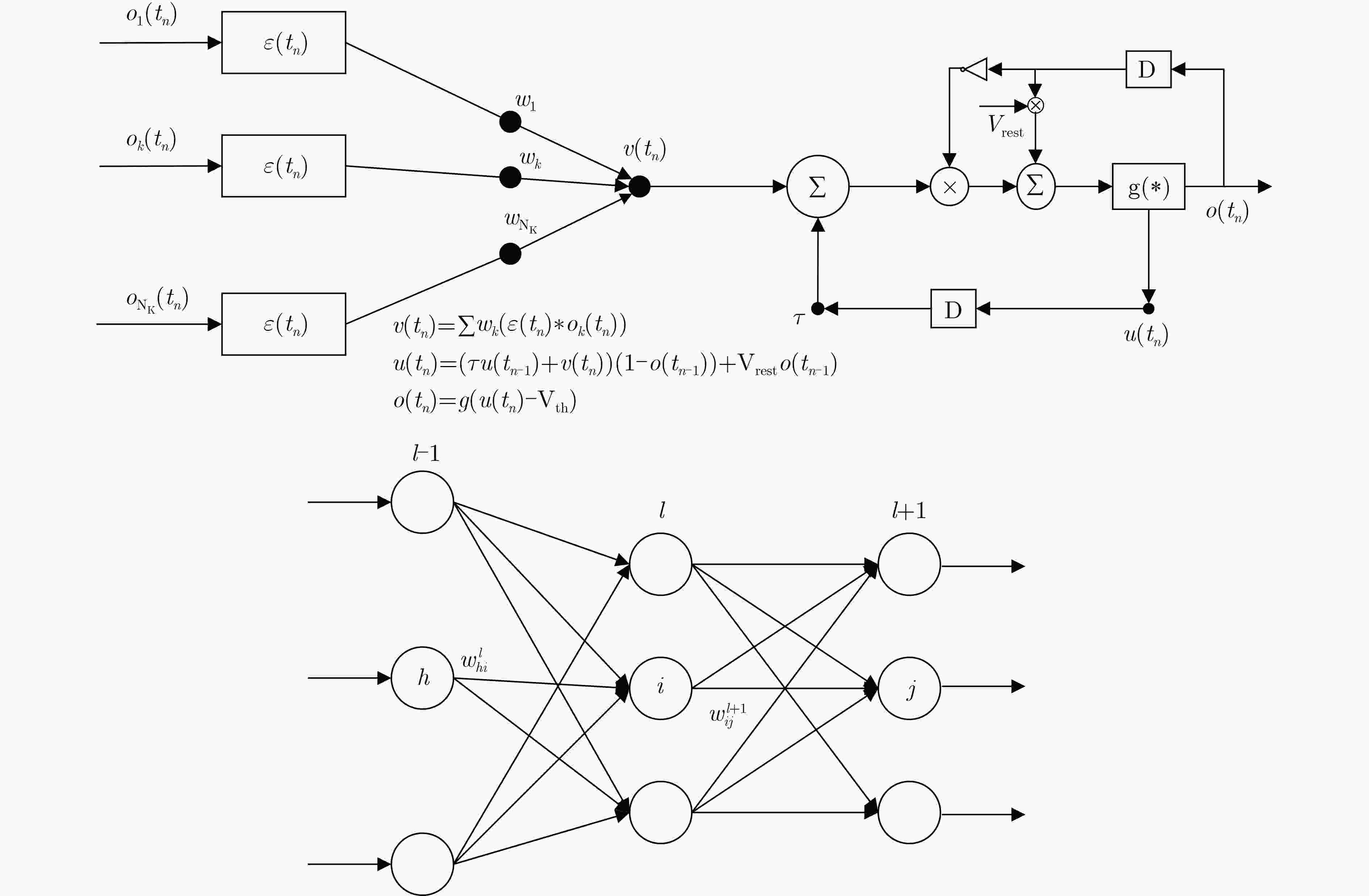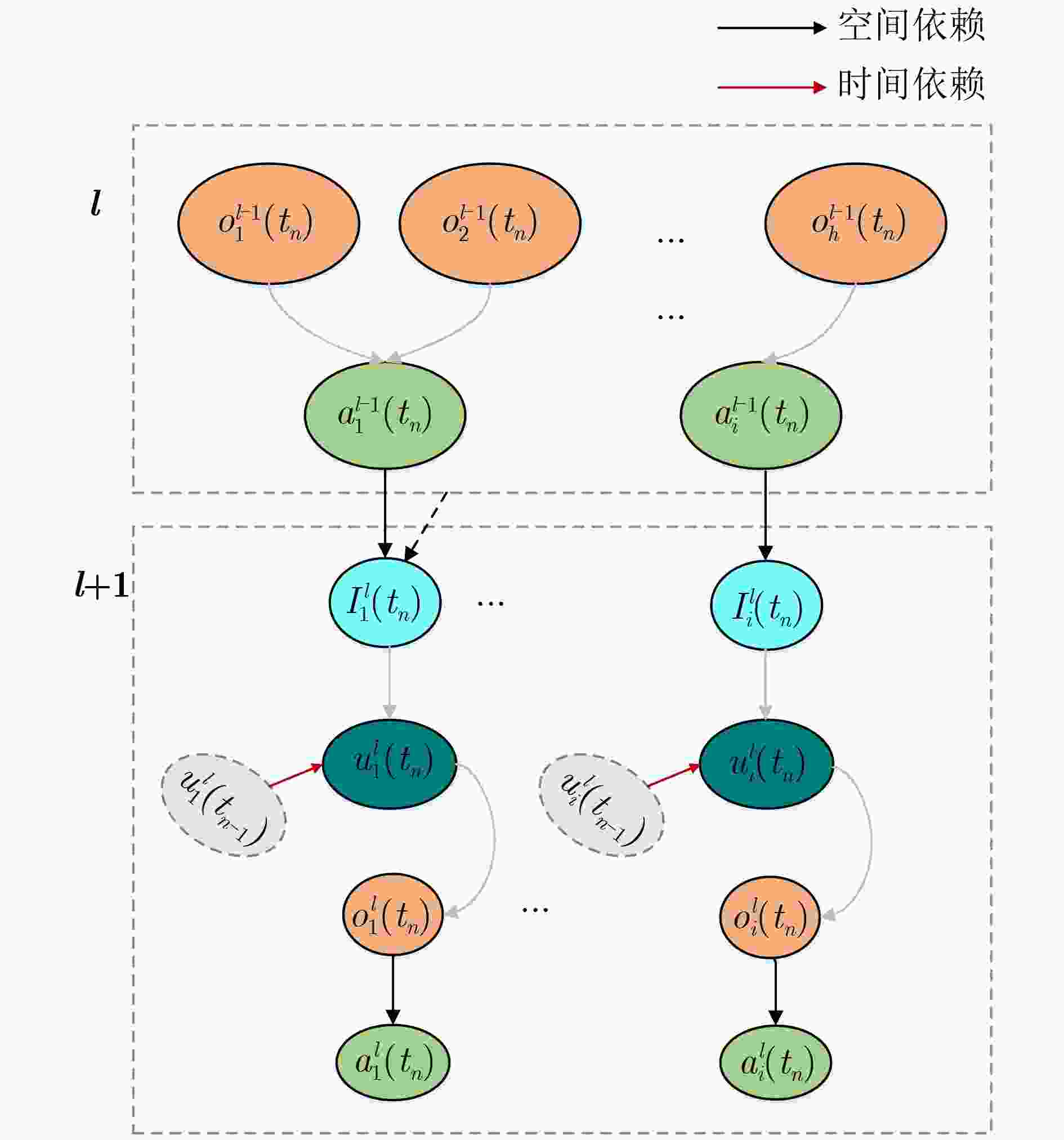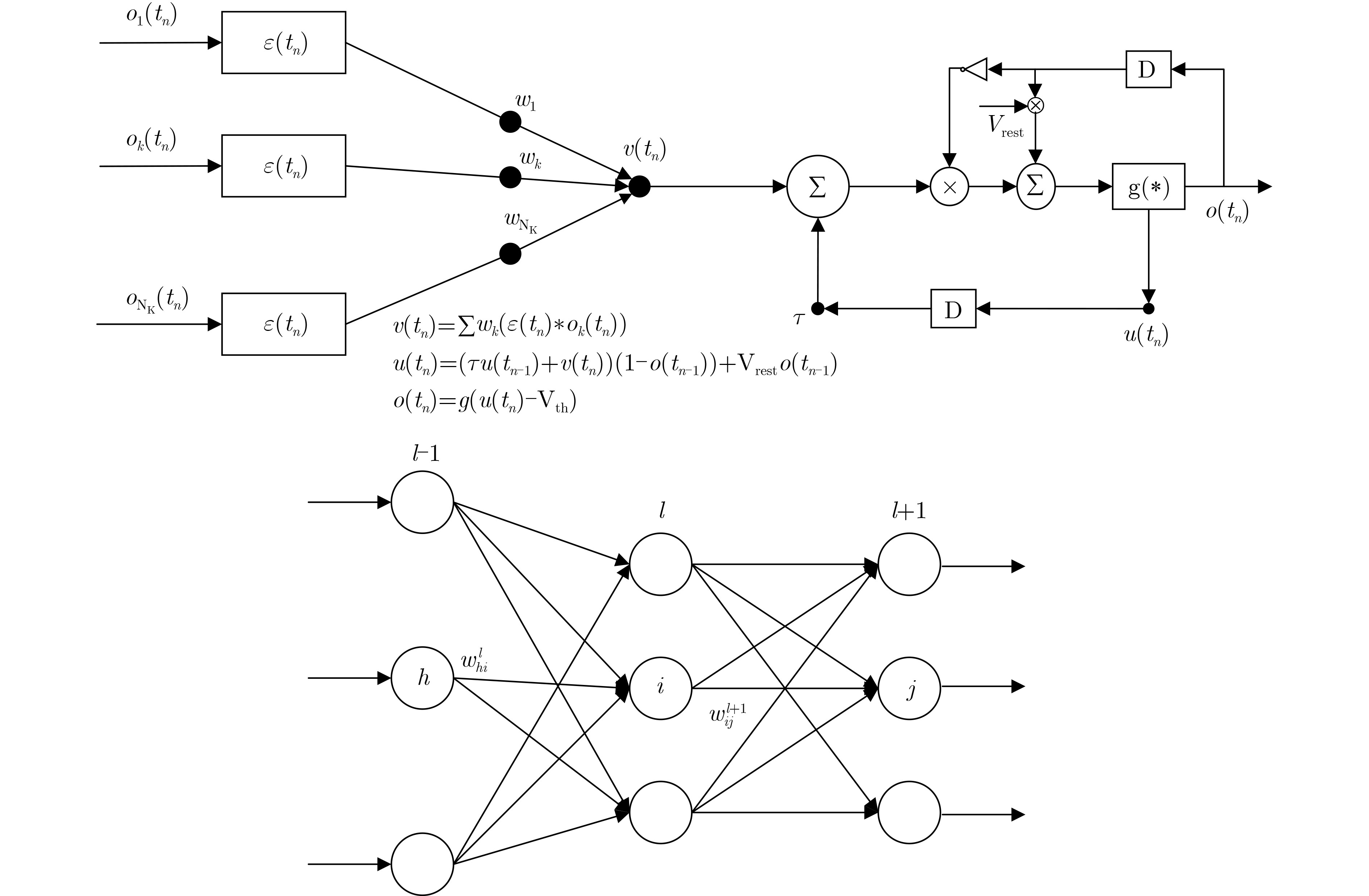Spiking Sequence Label-Based Spatio-Temporal Back-Propagation Algorithm for Training Deep Spiking Neural Networks
-
摘要: 尖峰放电的脉冲神经网络(SNN)具有接近大脑皮层的信号处理模式,被认为是实现大脑启发计算的重要途径。但是,目前对于深度脉冲神经网络的学习仍缺乏有效的监督学习算法。受尖峰放电速率标识的时空反向传播算法的启发,该文提出一种面向深度脉冲神经网络训练的基于时间脉冲序列标识的监督学习算法,通过定义突触后电位和膜电位反传迭代因子分别分析脉冲神经元的空间和时间依赖关系,使用替代梯度的方法解决反传过程中不连续可微的问题。不同于现有基于尖峰放电速率标识的学习算法,该算法能够充分反映了脉冲神经网络输出的时间脉冲序列的动态特性。因此,所提算法非常适合应用于需要较长时间序列标识的计算任务,例如行为的时间脉冲序列控制。该文在静态图像数据集CIFAR10和神经形态数据集NMNIST上验证了所提算法的有效性,在所有这些数据集上都显示出良好的性能,这有助于进一步研究基于时间脉冲序列应用的大脑启发计算。Abstract: Spiking Neural Networks (SNN) have a signal processing mode close to the cerebral cortex, which is considered to be an important approach to realize brain-inspired computing. However, the lack of effective supervised learning algorithms for deep spiking neural networks has been a great challenge for spiking sequence label-based brain-inspired computing tasks. A supervised learning algorithm for training deep spiking neural network is proposed in this paper. It is an error backpropagation algorithm that uses surrogate gradient to solve the problem of non-differentiable spike generation function, and define the postsynaptic potential and membrane potential reversal iteration factors represent the spatial and temporal dependencies of pulsed neurons, respectively. It differs from existing learning algorithms based on firing rate encoding, fully reflects analytically the temporal dynamic properties of the spiking neuron. Therefore, the algorithm proposed in this paper is well-suited for application to tasks that require longer time sequences rather than spiking firing rates, such as behavior control. Proposed algorithm is validated on the static image datasets CIFAR10, and the neuromorphic dataset NMNIST. It shows good performance on all these datasets, which helps to further investigate spike-based brain-inspired computation.
-
1 伪代码
input : Network inputs X, class label Y, initial weight vector$\{ {W^l}\} _{l = 1}^L$, membrane decay factor ${\tau _m}$, synaptic decay factor ${\tau _s}$, threshold potential ${V_{\rm{th}}}$,simulation windows T output : Output Spike Sequence ${O^L}$ 1 Forward Pipeline : 2 $v_{0:T - 1}^1 \;\; \leftarrow \;\;repeat\;input\;X\;through\;T$ 3 ${\text{target}} \;\; \leftarrow \;\;encode\_repeat(Y)$ 4 for $l\; \leftarrow \;2$ to L do 5 for $t\; \leftarrow \;0$ to $T\; \leftarrow \;1$ do 6 $u_t^l,\;\;o_t^l\;\; \leftarrow \;\;Update\_neuron\_state({w^l},v_t^{l - 1},u_{t - 1}^l,{\tau _m},{V_{th}})$ /Eq.(4)-(5) 7 $v_t^l\;\; \leftarrow \;\;Compute\_psp(o_t^l)$ /Eq.(3a) 8 end 9 end 10 $Loss \;\; \leftarrow \;\;loss\_function({O^L},{\text{target}})$ 11 Backward Pipeline : 12 for $l \;\; \leftarrow \;\;L$ to 1 do 13 for $t \;\; \leftarrow \;\;T - 1$ to 0 do 14 if $t = T$ and $l = L$ then 15 $ \hat \delta _{ T - 1}^L \;\; \leftarrow \;\;Initial\_psp\_iteration\_factor \left(\dfrac{{\partial L}}{{\partial a_{T - 1}^L}}\right) $ /Eq.(13) 16 $ \tilde \delta _{T - 1}^L \;\; \leftarrow \;\;Initial\_mem\_iteration\_factor \left(\hat \delta _{ T - 1}^L,\frac{{\partial a_{T - 1}^L}}{{\partial u_{\ T - 1}^L}}\right) $ /Eq.(12) 17 end 18 else if $t = T - 1$ and $l! = L$ then 19 $ \hat \delta _{ T - 1}^l \;\; \leftarrow \;\;Update\_psp\_iteration\_factor(\hat \delta _{ T - 1}^{l + 1},{w^{l + 1}},u_{ T - 1}^{l + 1},o_{ T - 2}^{l + 1}) $ /Eq.(15) 20 $ \tilde \delta _{T - 1}^l \;\; \leftarrow \;\;Update\_mem\_iteration\_factor(\hat \delta _{ T - 1}^l,u_{ T - 1}^l) $ /Eq.(14) 21 end 22 else if $t! = T - 1$ and $l = L$ then 23 $ \hat \delta _t^L \;\; \leftarrow \;\;Update\_psp\_iteration\_factor(\hat \delta _{ T + 1}^L,o_{ T + 1}^L,u_{T + 1}^L,u_t^L) $ /Eq.(17) 24 $ \tilde \delta _t^L \;\; \leftarrow \;\;Update\_mem\_iteration\_factor(\hat \delta _t^L,u_t^L,\tilde \delta _{T + 1}^L,o_t^L) $ /Eq.(16) 25 end 26 else 27 $ \hat \delta _t^l \;\; \leftarrow \;\;Update\_psp\_iteration\_factor(\hat \delta _t^{l + 1},o_{ T - 1}^{l + 1},u_t^{l + 1},\hat \delta _{T + 1}^l,u_t^l,u_{ T + 1}^l,o_t^l) $ /Eq.(11) 28 $ \tilde \delta _t^l \;\; \leftarrow \;\;Update\_mem\_iteration\_factor(\hat \delta _t^l,u_t^l,\tilde \delta _{ T + 1}^l,o_t^l) $ /Eq.(10) 29 end 30 end 31 end 32 $ Update{\text{ W based on: }}\Delta {W^l} = \sum\nolimits_{ T = 0}^{T - 1} {a_t^{l - 1}\tilde \delta _t^l} $ /Eq.(18) 表 1 CIFAR10的测试结果(van Rossum距离)
表 2 NMNIST的测试结果(van Rossum距离)
方法 网络 时间步长 周期 准确率(%) STBP[12] 12C5-P2-64C5-P2 50 150 98.19 本文算法 12C5-P2-64C5-P2 25 100 98.61 表 3 CIFAR10的测试结果(Hamming距离)
表 4 NMNIST的测试结果(Hamming距离)
方法 网络 时间步长 周期 准确率(%) STBP[12] 12C5-P2-64C5-P2 50 150 98.19 本文算法 12C5-P2-64C5-P2 25 100 98.67 -
[1] YAMAZAKI K, VO-HO V K, BULSARA D, et al. Spiking neural networks and their applications: A review[J]. Brain Sciences, 2022, 12(7): 863. doi: 10.3390/brainsci12070863. [2] MAKAROV V A, LOBOV S A, SHCHANIKOV S, et al. Toward reflective spiking neural networks exploiting memristive devices[J]. Frontiers in Computational Neuroscience, 2022, 16: 859874. doi: 10.3389/fncom.2022.859874. [3] BÜCHEL J, ZENDRIKOV D, SOLINAS S, et al. Supervised training of spiking neural networks for robust deployment on mixed-signal neuromorphic processors[J]. Scientific Reports, 2021, 11(1): 23376. doi: 10.1038/s41598-021-02779-x. [4] ASGHAR M S, ARSLAN S, and KIM H. A low-power spiking neural network chip based on a compact LIF neuron and binary exponential charge injector synapse circuits[J]. Sensors, 2021, 21(13): 4462. doi: 10.3390/s21134462. [5] ROY K, JAISWAL A, and PANDA P. Towards spike-based machine intelligence with neuromorphic computing[J]. Nature, 2019, 575(7784): 607–617. doi: 10.1038/s41586-019-1677-2. [6] HODGKIN A L and HUXLEY A F. A quantitative description of membrane current and its application to conduction and excitation in nerve[J]. The Journal of Physiology, 1952, 117(4): 500–544. doi: 10.1113/jphysiol.1952.sp004764. [7] ZHAN Qiugang, LIU Guisong, XIE Xiurui, et al. Effective transfer learning algorithm in spiking neural networks[J]. IEEE Transactions on Cybernetics, 2022, 52(12): 13323–13335. doi: 10.1109/TCYB.2021.3079097. [8] LUO Xiaoling, QU Hong, WANG Yuchen, et al. Supervised learning in multilayer spiking neural networks with spike temporal error backpropagation[J]. IEEE Transactions on Neural Networks and Learning Systems, 2023, 34(12): 10141–10153. doi: 10.1109/TNNLS.2022.3164930. [9] JIANG Runhao, ZHANG Jie, YAN Rui, et al. Few-shot learning in spiking neural networks by multi-timescale optimization[J]. Neural Computation, 2021, 33(9): 2439–2472. doi: 10.1162/neco_a_01423. [10] XIE Xiurui, YU Bei, LIU Guisong, et al. Effective active learning method for spiking neural networks[J]. IEEE Transactions on Neural Networks and Learning Systems, 2024: 1–10. doi: 10.1109/TNNLS.2023.3257333. [11] SENGUPTA A, YE Yuting, WANG R, et al. Going deeper in spiking neural networks: VGG and residual architectures[J]. Frontiers in Neuroscience, 2019, 13: 95. doi: 10.3389/fnins.2019.00095. [12] WU Yujie, DENG Lei, LI Guoji, et al. Spatio-temporal backpropagation for training high-performance spiking neural networks[J]. Frontiers in Neuroscience, 2018, 12: 331. doi: 10.3389/fnins.2018.00331. [13] WU Yujie, DENG Lei, LI Guoji et al. Direct training for spiking neural networks: Faster, larger, better[C]. The 33th AAAI Conference on Artificial Intelligence, California, USA, 2019: 1311–1318. doi: 10.1609/aaai.v33i01.33011311. [14] VAN ROSSUM M C. A novel spike distance[J]. Neural Computation, 2001, 13(4): 751–763. doi: 10.1162/089976601300014321. [15] BOHTE S M, KOK J N, and LA POUTRÉ H. Error-backpropagation in temporally encoded networks of spiking neurons[J]. Neurocomputing, 2002, 48(1/4): 17–37. doi: 10.1016/S0925-2312(1)00658-0. [16] XIAO Mingqing, MENG Qingyan, ZHANG Zongpeng, et al. SPIDE: A purely spike-based method for training feedback spiking neural networks[J]. Neural Networks, 2023, 161: 9–24. doi: 10.1016/j.neunet.2023.01.026. [17] GUO Yufei, HUANG Xuhui, and MA Zhe. Direct learning-based deep spiking neural networks: A review[J]. Frontiers in Neuroscience, 2023, 17: 1209795. doi: 10.3389/fnins.2023.1209795. [18] ZENKE F and GANGULI S. SuperSpike: Supervised learning in multilayer spiking neural networks[J]. Neural Computation, 2018, 30(6): 1514–1541. doi: 10.1162/neco_a_01086. [19] ZHANG Wenrui and LI Peng. Temporal spike sequence learning via backpropagation for deep spiking neural networks[C]. 34th International Conference on Neural Information Processing Systems, Vancouver, Canada, 2020: 1008. [20] KRIZHEVSKY A, NAIR V, and HINTON G. The CIFAR-10 dataset[EB/OL]. https://www.cs.toronto.edu/~kriz/cifar.html, 2009. [21] ORCHARD G, JAYAWANT A, COHEN G K, et al. Converting static image datasets to spiking neuromorphic datasets using saccades[J]. Frontiers in Neuroscience, 2015, 9: 437. doi: 10.3389/fnins.2015.00437. [22] ZENKE F and VOGELS T P. The remarkable robustness of surrogate gradient learning for instilling complex function in spiking neural networks[J]. Neural Computation, 2021, 33(4): 899–925. doi: 10.1162/neco_a_01367. [23] TAVANAEI A, GHODRATI M, KHERADPISHEH S R, et al. Deep learning in spiking neural networks[J]. Neural Networks, 2019, 111: 47–63. doi: 10.1016/j.neunet.2018.12.002. [24] HUNSBERGER E and ELIASMITH C. Training spiking deep networks for neuromorphic hardware[EB/OL]. https://arxiv.org/abs/1611.05141, 2016. -






 下载:
下载:



